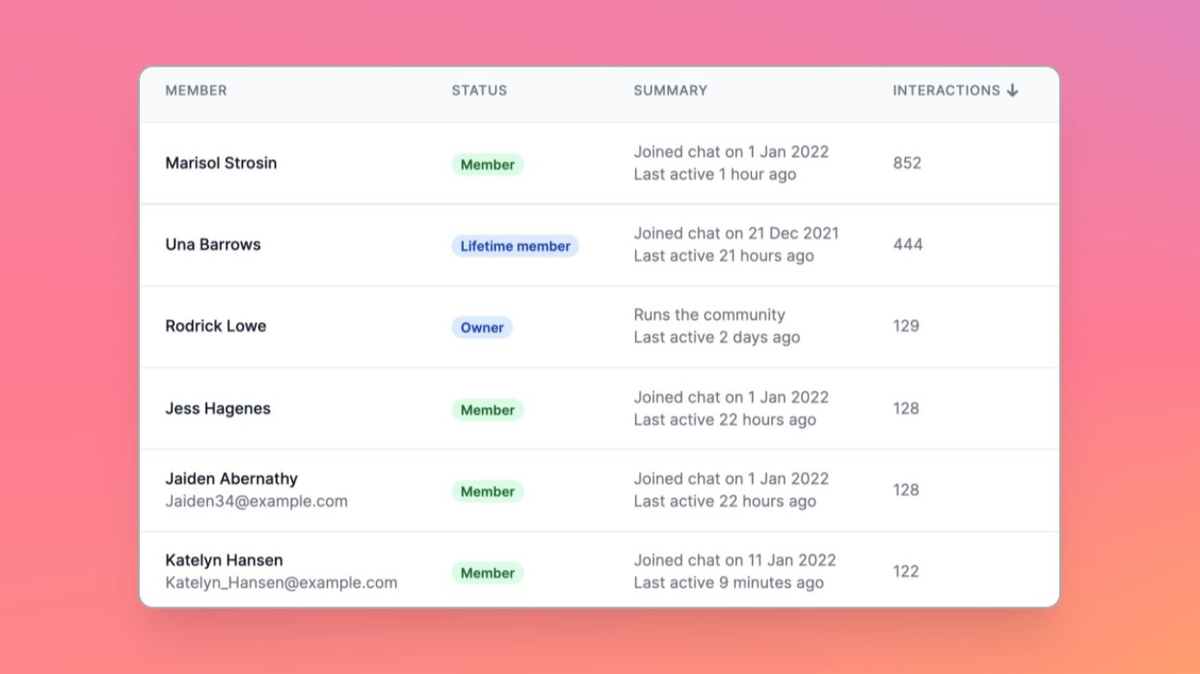Keep your community healthy by monitoring key metrics

“What gets measured gets managed” is a much-loved management quote, usually misattributed to Peter Drucker.
The reverse should also hold true: “What gets managed should get measured”.
If you're managing a community, it's your job to regularly check-in and find out how it's doing. You need to monitor its vital signs to keep it healthy.
To do this effectively, you need community analytics. Here at Levellr we see the importance of this data as we work with clients from Fall Out Boy to Starbucks to create happy, thriving communities on Discord and other apps.
Here are 5 key metrics you should be measuring for your community.
1) Total community members — how many participants do you have?
In the early days of a community, growth is a critical component to keep momentum and drive activity as members get to know one another. Knowing how you're growing is critical so you can put your promotional effort in the right places where you actually get results. And seeing that number go up can be super encouraging!

But I know, I know: not every community wants to grow. Some are best kept small! But even in that case, you still need to keep tabs on your member count. If too many leave, small communities rapidly stagnate. Even the cosiest community needs to maintain itself to stay healthy.
Whether you're shooting the moon or staying cosy, you should know how membership is changing.
2) Interactions in the last 14 days — how alive is the community?
Nobody likes a ghost town! 👻
As a community management, your first job is to figure out how much activity your community needs to feel alive. Do you need a message per day? 20 messages? Does your community do well with weekly bursts of activity centered around events, or do you prefer a constant chat?

Once you know what works for you and your community members, you need to measure that interaction. How many interactions do you see over the time period that matters to you? Are you getting enough right now? If activity declines, you need to know — and it's your job to drive it back up!
It's critical to know how many messages are being sent.
3) The percentage of members who are interacting — how's the lurker-to-contributor ratio?
Community guru @rosiesherry reminds us “lurkers are people too”.
Some lurkers are learners, or watchers, or followers. Some are introverts, first-timers, or finding the courage to take part. Some are well-intentioned silent advocates, loyal fans, or interested outsiders. Love them all and welcome them all.

But any vibrant community needs at least a few active posters to generate material for those lurkers to enjoy!
What's the magic number? It'll vary, but in general you should be looking for a healthy ratio of 1:4 or 1:5 (with more lurkers than posters).
4) Which members are interacting — who are your community pillars?
As we saw above, your most core contributors will be setting the pace and tone for the whole community. They're giving your silent members great content, insight or wit to enjoy! And in a very real way, they are the voice of your community.
This makes it super important to know who they are. Who posts the most? How is this changing over time? Who values quality over quantity?

Keep an eye on who is contributing most to your group, figure out who are the real pillars of the community, and reward them when you can.
A reward doesn't need to involving spending money — sometimes just having the community manager or host publicly acknowledge great, high quality contributions is a wonderful reward in itself.
5) Churn — how many people are leaving your community or becoming inactive?
Every community loses members. Many people lose interest, or get tired of talking about the same topic, or something changes in their life circumstances and they simply can't afford the time to take part anymore. Sometimes they'll just interact less, but often they will leave a community altogether.
This is natural. It's okay. It's not a sign of failure. But we don't want it to get out of control!

We call the rate of member attrition “churn”.
Keep an eye out for sharp increases in churn. If a lot of people suddenly leave after a period of relative consistency or stability, you have a strong signal that something has changed. Try to figure out what it is, and whether you can fix it.
Then — going back to metric #1 — consider how to replace those members.
So, how do you measure your community vitals?
These stats are important no matter what community you run — paid or free, large or small, fun or professional. If you keep these stats healthy, your community will stay vibrant.
The screenshots in this post all come from Levellr community analytics.

Levellr provides everything you need to bring your community together in a free, invite‑only, or pay‑to‑access messaging group in Telegram.
We give you:
- A beautiful community landing page
- Community analytics like these
- Access controls such as email signup or a paywall
- Insights into your community members
- A helping hand as you learn and grow in the world of community
Your superfans are waiting. Contact Levellr today to find out how you can build a community which works for your brand.